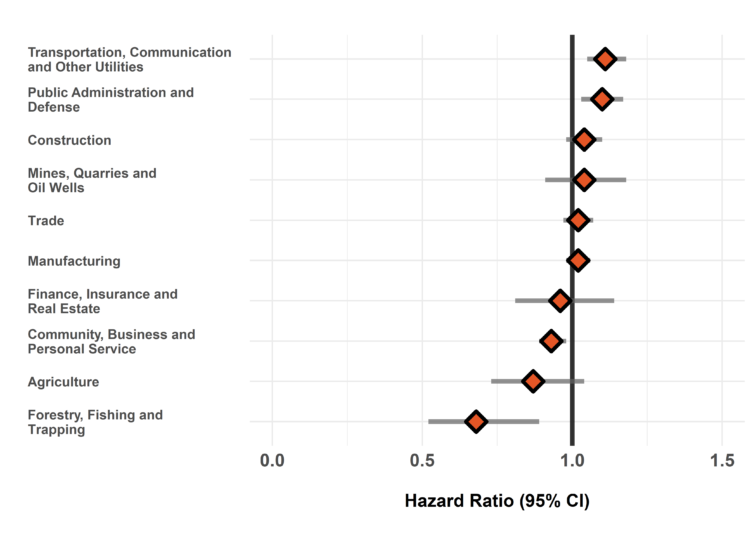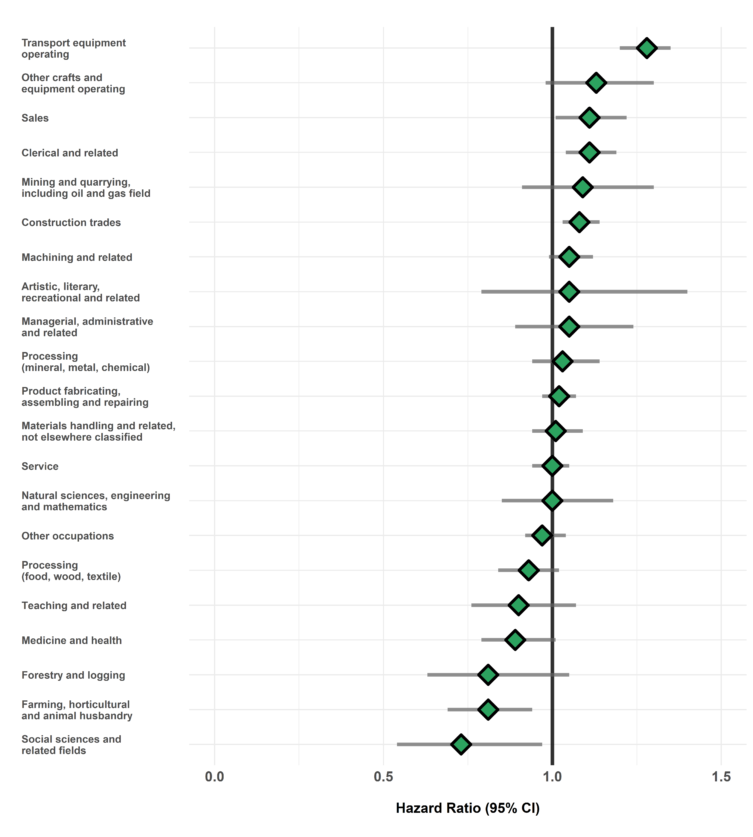Bladder Cancer
Background
Among Canadians, urinary bladder cancer is the fifth most common cancer diagnosis [1]. Men are three times more likely to be diagnosed with bladder cancer than women. The most prominent and well-established risk factor for this cancer is tobacco smoking. Other non-occupational risk factors include exposure to arsenic in drinking water and radiation during medical treatment.
Bladder cancer is an important occupational disease. There is strong evidence of an association between bladder cancer and several workplace exposures. The Occupational Cancer Research Centre estimates that between 3-12% of bladder cancers in Canada are attributable to occupational exposures [2]. Although some known bladder carcinogens have declined in use since the 1980s, other suspected agents remain common in the workplace. Research conducted by the OCRC indicates that an estimated 280 bladder cancer cases per year in Canada may be attributable to workplace diesel engine exhaust and polycyclic aromatic hydrocarbon exposure alone [2].
Known occupational risk factors
-
- Aromatic amines (auramine production, benzidine, 2-naphthylamine, o-toluidine, 4-aminobiphenyl) [3]
- Arsenic and inorganic arsenic compounds [3]
- Employment in aluminum or rubber production or work as a painter [3]
Possible occupational risk factors
-
- Diesel engine exhaust [3]
- Polycyclic aromatic hydrocarbons (PAHs) [4]
- Coal-tar pitch [3]
- Tetrachloroethylene [3]
- Employment as a hair dresser, barber, or welder
Key Findings
Increased risks of bladder cancer were observed among workers in transportation, construction and metal manufacturing, and some managerial and administrative occupations. Increased risk of bladder cancer was observed among some workers in rubber and plastics processing occupations, although estimates for workers in this sector overall were lower than expected. Occupational variation in smoking may contribute to observed differences in bladder cancer risk. Too few cases were observed among hair dressers and barbers and dry cleaners to examine the risk of bladder cancer for these groups.
Transportation
 Many workers in transportation occupations are regularly exposed to diesel engine exhaust, which is a suspected bladder carcinogen.
Many workers in transportation occupations are regularly exposed to diesel engine exhaust, which is a suspected bladder carcinogen.
-
- All transportation occupations: 1.28 times the risk
- Taxi drivers: 1.57 times the risk
- Bus drivers: 1.41 times the risk
- Truck drivers: 1.28 times the risk
- Railway transport operating occupations: 1.19 times the risk
- Air transport operating occupations: 1.15 times the risk
- All transportation occupations: 1.28 times the risk
Construction
 Overall, construction workers showed only a slightly increased risk of bladder cancer, but some trades were associated with higher risks. Construction workers may be exposed to diesel engine exhaust, a known bladder carcinogen, and may also be exposed to solvents and fumes which could be linked to bladder cancer risk.
Overall, construction workers showed only a slightly increased risk of bladder cancer, but some trades were associated with higher risks. Construction workers may be exposed to diesel engine exhaust, a known bladder carcinogen, and may also be exposed to solvents and fumes which could be linked to bladder cancer risk.
-
- All construction occupations: 1.08 times the risk
- Occupations in labouring and other elemental work: electrical power, lighting and wire communications: 1.62 times the risk
- Excavating, grading, paving and related occupations (foremen/forewomen): 1.29 times the risk
- Plasterers and related occupations: 1.25 times the risk
- Bricklayers, stonemasons, and tile setters: 1.24 times the risk
- Concrete finishers and related occupations: 1.24 times the risk
- Pipefitters and plumbers: 1.24 times the risk
- Construction electricians and repairers: 1.17 times the risk
- Painters, paperhangers and related occupations: 1.14 times the risk
- All construction occupations: 1.08 times the risk
Metalworking
 Metalworkers are exposed to a variety of occupational hazards, including metal dusts, welding fumes and chemical solvents. Metalworkers can be exposed to known bladder carcinogens, such as aromatic amines through use of metalworking fluids and polycyclic aromatic hydrocarbons (PAHs) in foundry processes. Excess risks were also observed for workers in some primary metal industries, including aluminum, with exposure to PAHs and other known and suspected bladder carcinogens.
Metalworkers are exposed to a variety of occupational hazards, including metal dusts, welding fumes and chemical solvents. Metalworkers can be exposed to known bladder carcinogens, such as aromatic amines through use of metalworking fluids and polycyclic aromatic hydrocarbons (PAHs) in foundry processes. Excess risks were also observed for workers in some primary metal industries, including aluminum, with exposure to PAHs and other known and suspected bladder carcinogens.
-
- Forging occupations: 1.63 times the risk
- Metal shaping and forming occupations (foremen/forewomen): 1.33 times the risk
- Metal machining occupations (foremen/forewomen): 1.26 times the risk
- Boilermakers, platers, and structural metalworkers: 1.21 times the risk
- Welding and flame cutting occupations: 1.09 times the risk
- Iron and steel mill industry: 1.25 times the risk
- Aluminum rolling, casting and extruding industry: 1.35 times the risk
Rubber and plastics
 Historically, manufacturing processes in rubber and plastics industries used aromatic amines, which are now known bladder carcinogens [4]. However, the use of many aromatic amines has declined in manufacturing processes in Canada since the 1980s due to legislative control. We observed a slightly elevated risk of bladder cancer among workers in rubber manufacturing industries in Ontario, and we observed elevated risk in some specific occupation groups, although the number of cases in these groups was relatively few. Bladder cancer risks from the rubber and plastics industries are described in more detail by DeBono et al. [6].
Historically, manufacturing processes in rubber and plastics industries used aromatic amines, which are now known bladder carcinogens [4]. However, the use of many aromatic amines has declined in manufacturing processes in Canada since the 1980s due to legislative control. We observed a slightly elevated risk of bladder cancer among workers in rubber manufacturing industries in Ontario, and we observed elevated risk in some specific occupation groups, although the number of cases in these groups was relatively few. Bladder cancer risks from the rubber and plastics industries are described in more detail by DeBono et al. [6].
-
- Fabricating, assembling and repairing occupations, rubber, plastic and related products (foremen/forewomen): 1.70 times the risk
- Occupations in labouring and other elemental work: fabricating, assembling and repairing rubber, plastic and related products: 1.26 times the risk
- Manufacturers of plastics and synthetic resins (industry): 1.47 times the risk
- Rubber products industries: 1.09 times the risk
White collar occupations
 Excess risks among these occupations could be related to environmental, lifestyle, or tobacco-related exposures. Printing processes have been classified as possibly carcinogenic by IARC, but evidence for bladder cancer was weak [7].
Excess risks among these occupations could be related to environmental, lifestyle, or tobacco-related exposures. Printing processes have been classified as possibly carcinogenic by IARC, but evidence for bladder cancer was weak [7].
-
- Receptionists and information clerks: 2.00 times the risk
- Production clerks: 1.55 times the risk
- Bookkeepers and accounting clerks: 1.47 times the risk
- Publishing and printing industries: 1.38 times the risk
Relative Risk by Industry and Occupation
Figure 1. Risk of bladder cancer diagnosis among workers employed in each industry group relative to all others, Occupational Disease Surveillance System (ODSS), 1999-2016

The hazard ratio is an estimate of the average time to diagnosis among workers in each industry/occupation group divided by that in all others during the study period. Hazard ratios above 1.00 indicate a greater risk of disease in a given group compared to all others. Estimates are adjusted for birth year and sex. The width of the 95% Confidence Interval (CI) is based on the number of cases in each group (more cases narrows the interval).
Figure 2. Risk of bladder cancer diagnosis among workers employed in each occupation group relative to all others, Occupational Disease Surveillance System (ODSS), 1999-2016

The hazard ratio is an estimate of the average time to diagnosis among workers in each industry/occupation group divided by that in all others during the study period. Hazard ratios above 1.00 indicate a greater risk of disease in a given group compared to all others. Estimates are adjusted for birth year and sex. The width of the 95% Confidence Interval (CI) is based on the number of cases in each group (more cases narrows the interval).
Table of Results
Table 1. Surveillance of Bladder Cancer: Number of cases, workers employed, and hazard ratios in each industry (SIC)
| SIC Code * | Industry Group | Number of cases | Number of workers employed | Hazard Ratio (95% CI) † |
| 1 | Agriculture | 124 | 35,005 | 0.87 (0.73-1.04) |
| 2/3 | Forestry, Fishing and Trapping |
53 | 10,698 | 0.68 (0.52-0.89) |
| 4 | Mines, Quarries and Oil Wells |
222 | 23,194 | 1.04 (0.91-1.18) |
| 5 | Manufacturing | 4,235 | 693,400 | 1.02 (0.98-1.06) |
| 6 | Construction | 1,296 | 210,913 | 1.04 (0.98-1.10) |
| 7 | Transportation, Communication and Other Utilities |
1,278 | 197,146 | 1.11 (1.05-1.18) |
| 8 | Trade | 1,731 | 429,174 | 1.02 (0.97-1.07) |
| 9 | Finance, Insurance and Real Estate |
138 | 23,975 | 0.96 (0.81-1.14) |
| 10 | Community, Business and Personal Service |
1,935 | 599,509 | 0.93 (0.89-0.98) |
| 11 | Public Administration and Defense |
1,197 | 190,818 | 1.10 (1.03-1.17) |
| * SIC: Standard Industrial Classification (1970) | ||||
| † Hazard rate in each group relative to all others | ||||
Table 2. Surveillance of Bladder Cancer: Number of cases, workers employed, and hazard ratios in each occupation (CCDO) group
| CCDO Code * | Occupation Group | Number of cases | Number of workers employed | Hazard Ratio (95% CI) † |
| 11 | Managerial, administrative and related |
140 | 30,983 | 1.05 (0.89-1.24) |
| 21 | Natural sciences, engineering and mathematics |
139 | 26,341 | 1.00 (0.85-1.18) |
| 23 | Social sciences and related fields |
46 | 30,708 | 0.73 (0.54-0.97) |
| 25 | Religion | 0 | 128 | – |
| 27 | Teaching and related | 135 | 48,477 | 0.90 (0.76-1.07) |
| 31 | Medicine and health | 300 | 135,345 | 0.89 (0.79-1.01) |
| 33 | Artistic, literary, recreational and related |
48 | 14,986 | 1.05 (0.79-1.40) |
| 41 | Clerical and related | 846 | 197,308 | 1.11 (1.04-1.19) |
| 51 | Sales | 486 | 148,076 | 1.11 (1.01-1.22) |
| 61 | Service | 1,548 | 370,804 | 1.00 (0.94-1.05) |
| 71 | Farming, horticultural and animal husbandry |
168 | 50,139 | 0.81 (0.69-0.94) |
| 73 | Fishing, hunting, trapping and related |
<5 | 558 | – |
| 75 | Forestry and logging | 59 | 10,683 | 0.81 (0.63-1.05) |
| 77 | Mining and quarrying, including oil and gas field |
126 | 13,037 | 1.09 (0.91-1.30) |
| 81 | Processing (mineral, metal, chemical) |
433 | 79,220 | 1.03 (0.94-1.14) |
| 82 | Processing (food, wood, textile) |
437 | 99,222 | 0.93 (0.84-1.02) |
| 83 | Machining and related | 1,267 | 189,346 | 1.05 (0.99-1.12) |
| 85 | Product fabricating, assembling and repairing |
2,023 | 328,219 | 1.02 (0.97-1.07) |
| 87 | Construction trades | 1,566 | 215,529 | 1.08 (1.03-1.14) |
| 91 | Transport equipment operating |
1,321 | 168,040 | 1.28 (1.2-1.35) |
| 93 | Materials handling and related, not elsewhere classified |
764 | 153,023 | 1.01 (0.94-1.09) |
| 95 | Other crafts and equipment operating |
200 | 28,295 | 1.13 (0.98-1.30) |
| 99 | Other occupations not elsewhere classified | 1,067 | 215,201 | 0.97 (0.92-1.04) |
| * CCDO: Canadian Classification Dictionary of Occupations (1971) | ||||
| † Hazard rate in each group relative to all others | ||||
Please note that ODSS results shown here may differ from those previously published or presented. This may occur due to changes in case definitions, methodological approaches, and the ongoing nature of the surveillance cohort.
References
- Canadian Cancer Statistics Advisory Committee. Canadian Cancer Statistics 2019. Toronto, ON: Canadian Cancer Society; 2019.
- Labrèche F, Kim J, Song C, Pahwa M, Ge CB, Arrandale VH, et al. The current burden of cancer attributable to occupational exposures in Canada. Prev Med. 2019;122:128–39.
- International Agency for Research on Cancer (IARC). List of Classifications by cancer sites with sufficient or limited evidence in humans, IARC Monographs Volumes 1-127 (2020).
- International Agency for Research on Cancer (IARC). Chemical agents and related occupations. IARC Monographs on the Evaluation of Carcinogenic Risks to Humans Vol. 100F (2012).
- International Agency for Research on Cancer (IARC). Welding, molybdenum trioxide, and indium tin oxide. IARC Monographs on the Evaluation of Carcinogenic Risks to Humans Vol. 118 (2018).
- Debono NL, Logar-Henderson C, Warden H, Shakik S, Dakouo M, MacLeod J, Demers PA. Cancer surveillance among workers in plastics and rubber manufacturing in Ontario, Canada. Occup Environ Med. 2020.
- International Agency for Research on Cancer (IARC). Printing Processes and Printing Inks, Carbon Black and Some Nitro Compounds. IARC Monographs on the Evaluation of Carcinogenic Risks to Humans Vol. 65 (1996).
